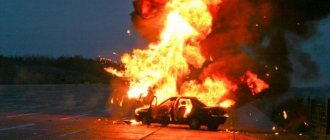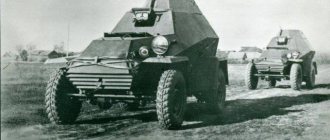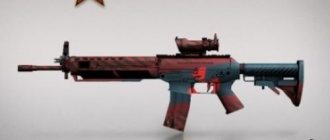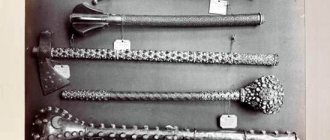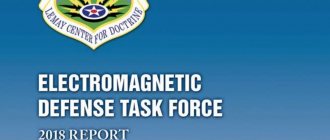Home / Ecology
Back
Published: November 28, 2014
Reading time: 5 min
1
51214
The basis of the destructive effect of chemical weapons are toxic substances (TS), which have a physiological effect on the human body.
Unlike other weapons, chemical weapons effectively destroy enemy personnel over a large area without destroying materiel. This is a weapon of mass destruction.
Together with the air, toxic substances penetrate into any premises, shelters, and military equipment. The damaging effect persists for some time, objects and the area become infected.
Types of toxic substances
- Types of toxic substances
- Characteristics of chemical weapons
- Damaging factors of chemical weapons
- First use of chemical weapons
- Chemical weapons of World War I
- Chemical weapons of mass destruction
- Types of protection
- Prohibited use
Toxic substances under the shell of chemical munitions are in solid and liquid form.
At the moment of their use, when the shell is destroyed, they come into combat mode:
- vaporous (gaseous);
- aerosol (drizzle, smoke, fog);
- drip-liquid.
Toxic substances are the main damaging factor of chemical weapons.
Interesting Facts
During the Great Patriotic War, the USSR conducted experiments on the use of chemical weapons on volunteers in order to produce a series of posters for the population with images of damage from chemical weapons. In July 1941, medical students (from among volunteers) were selected in Moscow and had drops of mustard gas and lewisite applied to the skin of their left forearm[20]. Since mustard gas and lewisite have a local analgesic effect, the volunteers did not feel pain during application[20]. The volunteers stayed at Lubyanka for several days until the marks of the lesion disappeared from their skin[20]. After this, light brown spots remained on the skin and all volunteers were sent home, forbidden to disclose this experience[21].
Characteristics of chemical weapons
These weapons are divided into:
- According to the type of physiological effects of OM on the human body.
- For tactical purposes.
- According to the speed of the onset of impact.
- According to the durability of the agent used.
- By means and methods of use.
Classification according to human exposure:
- Nerve agents. Lethal, fast-acting, persistent. Act on the central nervous system. The purpose of their use is rapid mass incapacitation of personnel with the maximum number of deaths. Substances: sarin, soman, tabun, V-gases.
- Agent of vesicant action. Lethal, slow-acting, persistent. They affect the body through the skin or respiratory system. Substances: mustard gas, lewisite.
- Generally toxic agent. Lethal, fast-acting, unstable. They disrupt the function of the blood to deliver oxygen to the tissues of the body. Substances: hydrocyanic acid and cyanogen chloride.
- Agent with asphyxiating effect. Lethal, slow-acting, unstable. The lungs are affected. Substances: phosgene and diphosgene.
- OM of psychochemical action. Non-lethal. Temporarily affect the central nervous system, affect mental activity, cause temporary blindness, deafness, a sense of fear, and limitation of movement. Substances: inuclidyl-3-benzilate (BZ) and lysergic acid diethylamide.
- Irritant agents (irritants). Non-lethal. They act quickly, but only for a short time. Outside the contaminated area, their effect ceases after a few minutes. These are tear and sneeze-producing substances that irritate the upper respiratory tract and can damage the skin. Substances: CS, CR, DM(adamsite), CN(chloroacetophenone).
Siege of Kaffa, 1346
During the siege of Kafa in 1346, an outbreak of bubonic plague began among the soldiers of the Tatar army (part of Genghis Khan's Mongol army). Wanting not to miss the opportunity to weaken the enemy's forces, the Tatars threw the corpses of their fallen, plague-ridden brothers under the city walls in order to deliberately infect enemy soldiers. The plan worked, and the residents of Kaffa were forced to abandon their city, surrendering it to the Mongol conquerors.
Those who survived the initial attack are believed to have left Caffa for Constantinople and other Mediterranean ports, contributing to the massive pandemic known as the Black Death.
✰ ✰ ✰
3
First use of chemical weapons
Chemist Fritz Haber was a consultant to the German War Ministry and is called the father of chemical weapons for his work in the development and use of chlorine and other poisonous gases. The government set him the task of creating chemical weapons with irritating and toxic substances. It’s a paradox, but Haber believed that with the help of gas warfare he would save many lives by ending trench warfare.
The history of use begins on April 22, 1915, when the German military first launched a chlorine gas attack. A greenish cloud appeared in front of the French soldiers' trenches, which they watched with curiosity.
When the cloud came close, a sharp smell was felt, and the soldiers’ eyes and nose stung. The fog burned my chest, blinded me, choked me. The smoke moved deeper into the French positions, spreading panic and death, and was followed by German soldiers with bandages on their faces, but they had no one to fight with.
By evening, chemists from other countries figured out what kind of gas it was. It turned out that any country can produce it. Rescue from it turned out to be simple: you need to cover your mouth and nose with a bandage soaked in a soda solution, and plain water on the bandage weakens the effect of chlorine.
After 2 days, the Germans repeated the attack, but the Allied soldiers soaked their clothes and rags in puddles and applied them to their faces. Thanks to this, they survived and remained in position. When the Germans entered the battlefield, the machine guns “spoke” to them.
Siege of Hatra, 198
When Septimius Severus' imperial Roman legion attacked Hatra in 198, his soldiers besieged the walls with a weapon that was highly innovative for the time: terracotta pots filled with deadly scorpions. Men threw pots over the walls, breaking them and releasing scorpions and other stinging insects such as wasps and bees.
Some residents of the besieged city died from the bites, others became sick and died due to a combination of the hot sun and the bites. These surprise pots proved incredibly effective, but Septimius was forced to retreat, resulting in the defeat of his army.
✰ ✰ ✰
6
Chemical weapons of World War I
On May 31, 1915, the first gas attack on the Russians took place. Russian troops mistook the greenish cloud for camouflage and brought even more soldiers to the front line. Soon the trenches were filled with corpses. Even the grass died from the gas.
In June 1915, a new poisonous substance, bromine, began to be used. It was used in projectiles.
In December 1915 - phosgene. It has a hay smell and a lingering effect. Its low cost made its use convenient. At first they were produced in special cylinders, and by 1916 they began to make shells.
Bandages did not protect against blister gases. It penetrated through clothing and shoes, causing burns on the body. The area remained poisoned for more than a week. This was the king of gases - mustard gas.
Not only the Germans, their opponents also began to produce gas-filled shells. In one of the trenches of the First World War, Adolf Hitler was poisoned by the British.
For the first time, Russia also used these weapons on the battlefields of the First World War.
Dura-Europos, 256 BC
When the Roman army is at your gates, you can use almost any method or means to keep them from invading. Sassanian soldiers in the city of Dura Europos, which was located in modern-day Syria, set fire to tar and brimstone in a tunnel that the Romans were digging to try to enter the city. The gas was so effective that 19 Roman soldiers died in this tunnel within two minutes. Soon after the siege, the city was abandoned and remained deserted for a long time, which makes it a valuable find for archaeologists, as its buildings and artifacts are very well preserved.
During the excavations, archaeologists discovered chemical traces of sulfur crystals, as well as the remains of Roman soldiers and one Sasanian; it was probably this person who brought the dangerous mixture into the tunnel.
✰ ✰ ✰
8
Chemical weapons of mass destruction
Experiments with chemical weapons took place under the guise of developing insect poisons.
Hydrocyanic acid, an insecticidal agent used in the gas chambers of Zyklon B concentration camps. Agent Orange is a substance used to defoliate vegetation. Used in Vietnam, soil poisoning caused severe illnesses and mutations in the local population.
In 2013, in Syria, in the suburbs of Damascus, a chemical attack was carried out on a residential area, killing hundreds of civilians, including many children. The nerve gas used was most likely sarin.
One of the modern variants of chemical weapons is binary weapons. It comes into combat readiness as a result of a chemical reaction after combining two harmless components.
Everyone who falls into the impact zone becomes victims of chemical weapons of mass destruction. Back in 1905, an international agreement on the non-use of chemical weapons was signed. To date, 196 countries around the world have signed up to its ban.
In addition to chemical weapons, weapons of mass destruction include nuclear and biological.
Links
- Filmstrip “Civil Defense. Practical standards", 1984
- Chemical disarmament open electronic journal. Detailed information about the process of destruction of chemical weapons in Russia (News, documents) - The site is temporarily unavailable (02/04/2010)
. - De-Lazari Alexander Nikolaevich, Chemical weapons on the fronts of the World War 1914-1918.
- Vladimir Voronov. Satan’s Last Argument: On the History of Chemical Weapons in Russia, 1916-1941 // Index/Dossier on Censorship, No. 12/2001.
- Vladimir Voronov. Mustard forest. // Top Secret, No. 11 (258), 2010.
- Fedorov L. A. Undeclared chemical war in Russia: politics against ecology, Moscow, 1995
- Encyclopedia of weapons. Chemical weapon
Prohibited use
Humanity was shocked by the terrible consequences and huge losses of people after the use of weapons of mass destruction. Therefore, in 1928, the Geneva Protocol prohibiting the use of asphyxiating, poisonous or other similar gases and bacteriological agents in war came into force. This protocol prohibits the use of not only chemical but also biological weapons. In 1992, another document came into force, the Chemical Weapons Convention. This document complements the Protocol; it speaks not only of a ban on the production and use, but also of the destruction of all chemical weapons. The implementation of this document is controlled by a specially created committee at the UN. But not all states signed this document; for example, Egypt, Angola, North Korea, and South Sudan did not recognize it. It also did not enter into legal force in Israel and Myanmar.
Swamps create a favorable ecological situation on Earth, the largest of them is the Vasyugan swamp.
Peat extraction on an industrial scale leads to the drainage of swamps; read the article about this phenomenon.
By clicking on the link, you will learn about the mysterious Manchac swamp.
In the 1990s, Russia had the largest stockpile of chemical weapons in the world. By 2013, the country had destroyed 76% of its reserves.
Notes
- M. Volodin “Chemical weapons with the smell of geranium”
- Kuntsevich A.D., Nazarkin Yu.K. US chemical warfare in Indochina Archived May 19, 2009, 1987
- Sergei Nelipovich: “The war made the revolution irreversible”
- Shirokorad A.
Chemical weapons: from the Crimean to the First World War // Bratishka: Monthly magazine of special forces. - M.: LLC "Vityaz-Bratishka", 2013. - No. 2. - P. 54-58.] - ↑ 1234
Belash E. “Myths of the First World War” M., “Veche”, 2012 - Nicolas Werth, Karel Bartošek, Jean-Louis Panné, Jean-Louis Margolin, Andrzej Paczkowski, Stéphane Courtois, The Black Book of Communism: Crimes, Terror and Repression
, Harvard University Press, 1999, hardcover, 858 pages, ISBN 0-674-07608- 7 - “Moreover, large quantities of chemical bombs with toxic substances were delivered to our airfields.
In a number of cases, our gunsmiths and pilots confused fragmentation and chemical bombs and went with them to bomb the Japanese. So, on August 2, the 4th squadron of the 53rd brigade attacked the Zaozernaya height instead of AO-10 fragmentation bombs with AOX-10 chemical fragmentation bombs, since they were very similar in appearance.” Alexander Shirokorad. Japan. Unfinished rivalry. Chapter 25. Conflict on Lake Khasan - Shcherbanov V. Paradoxes of the Adzhimushkay tragedy
- The US used defoliants and tear gas; North Vietnamese troops used tear gas.
- Iraqi rebels adopted the experience of the First World War (inaccessible link)
- In Iraq, militants used chemical weapons
- Decree of the Government of the Russian Federation of March 21, 1996 N 305 “ON THE APPROVAL OF THE FEDERAL TARGETED PROGRAM “DESTRUCTION OF CHEMICAL WEAPONS STOCKS IN THE RUSSIAN FEDERATION.” [1]
- OPCW: Russia has now destroyed 78% of its chemical weapons arsenal
- ↑ 12
The destruction of the largest arsenal of chemical weapons has been completed in Russia // Lenta.ru, 10/08/2015 - The last Russian chemical weapons destruction plant opened in Udmurtia
- Authorities: work on the destruction of chemical weapons has been completed near Kurgan // RIA Novosti, 11/20/2015
- Babich: The Russian Federation has practically completed the destruction of chemical weapons this year // RIA Novosti, 10.30.2015
- The last chemical munition destroyed in Leonidovka // Interfax, 08/17/2015
- Historical event: Russia destroyed all chemical weapons ahead of schedule
Siege of Fort Pitt, 1763
An outbreak of smallpox in the Ohio Valley in 1763 was the result of the struggle of British colonists besieged by Indians at Fort Pitt. Indian emissaries received gifts of items that belonged to smallpox patients, with the hope of spreading the disease among the Indian tribes.
General Amherst wrote that it was necessary to use every opportunity that the British could to weaken the Indians. The British smallpox plan was very successful in curbing Indian aggression due to the active spread of infection among the Indian population.
The spread of infection did not stop at Fort Pitt. Throughout the American Southeast, the Shawnee, Cherokee, Chickasaw, and Choctaw tribes were infected. Thousands of people were infected as a result of the transmission of contaminated three blankets and a handkerchief during the siege at Fort Pitt.
✰ ✰ ✰
Naples, Italy, 1495
Spanish soldiers, who were in southern Italy, tried to use one of the types of biological weapons. They added the blood of people suffering from leprosy to bottles of wine that they sold to the Italians. This was especially mean towards people, since it was then believed that, due to its disfiguring consequences for humans, leprosy was a curse and punishment from God.
This method of biological warfare had long-term consequences due to the way leprosy spread. The infection can remain asymptomatic in the human body for 5 to 20 years. For quick results, this method is not very effective.
✰ ✰ ✰
2



